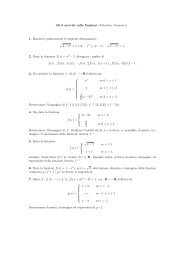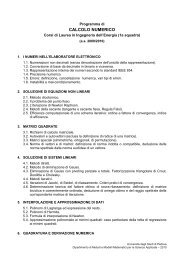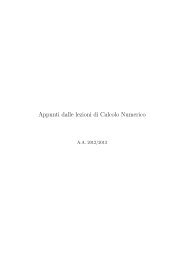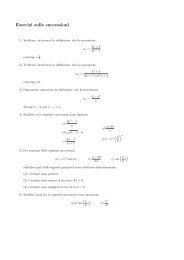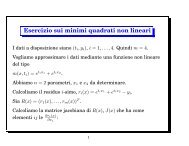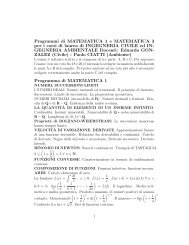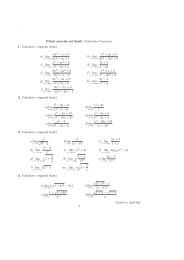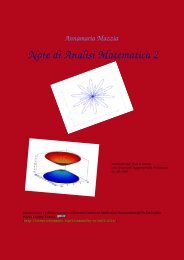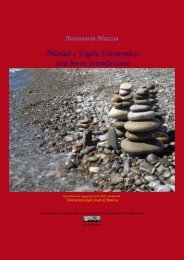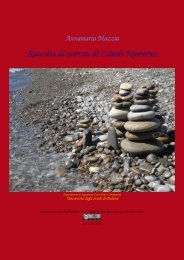Note di Analisi Matematica 2 - Esercizi e Dispense - Università degli ...
Note di Analisi Matematica 2 - Esercizi e Dispense - Università degli ...
Note di Analisi Matematica 2 - Esercizi e Dispense - Università degli ...
Create successful ePaper yourself
Turn your PDF publications into a flip-book with our unique Google optimized e-Paper software.
2. FUNZIONI REALI DI PIÙ VARIABILI<br />
x 0 . Se in<strong>di</strong>chiamo con A ɛ (x 0 ) questo insieme, possiamo <strong>di</strong>re che<br />
A ɛ (x 0 ) = {x ∈ R : |x − x 0 | < ɛ}<br />
Generalizziamo questa definizione in R n .<br />
Definizione 2.2.10 Dato P 0 ∈ R n e ɛ > 0, l’insieme dei punti P <strong>di</strong> R n che hanno <strong>di</strong>stanza da<br />
P 0 minore <strong>di</strong> ɛ prende il nome <strong>di</strong> intorno circolare <strong>di</strong> centro P 0 e raggio ɛ.<br />
In<strong>di</strong>chiamo con A ɛ (P 0 ) questo insieme, possiamo <strong>di</strong>re che<br />
A ɛ (P 0 ) = {P ∈ R n : |P − P 0 | < ɛ}<br />
G In R 2 , considerando P 0 (x 0 , y 0 ), e il generico punto P (x, y) si ha<br />
{<br />
A ɛ (P 0 ) = P (x, y) ∈ R 2 : √ }<br />
(x − x 0 ) 2 + (y − y 0 ) 2 < ɛ<br />
Osserviamo che l’equazione<br />
(x − x 0 ) 2 + (y − y 0 ) 2 = ɛ 2<br />
rappresenta l’equazione <strong>di</strong> una circonferenza <strong>di</strong> centro il punto (x 0 , y 0 ) e raggio ɛ. Quin<strong>di</strong><br />
l’intorno <strong>di</strong> (x 0 , y 0 ) è dato da tutti i punti contenuti all’interno della circonferenza (nel<br />
cerchio), ma non i punti che si trovano sulla circonferenza.<br />
G In R 3 , preso P 0 (x 0 , y 0 , z 0 ) e considerato P (x, y, z) il generico punto <strong>di</strong> R 3 , si ha<br />
{<br />
A ɛ (P 0 ) = P (x, y, z) ∈ R 3 : √ }<br />
(x − x 0 ) 2 + (y − y 0 ) 2 + (z − z 0 ) 2 < ɛ<br />
Dal momento che l’equazione<br />
(x − x 0 ) 2 + (y − y 0 ) 2 + (−z 0 ) 2 = ɛ 2<br />
rappresenta l’equazione della sfera <strong>di</strong> centro P 0 e raggio ɛ, l’intorno <strong>di</strong> P 0 è dato da tutti<br />
i punti che si trovano all’interno della sfera ma non sulla superficie della sfera.<br />
Ve<strong>di</strong>amo ora altre definizioni che saranno utili nel seguito.<br />
Definizione 2.2.11 Dato I ⊂ R n :<br />
G Diremo che un punto P 0 ∈ R n è un punto <strong>di</strong> frontiera <strong>di</strong> I se ogni intorno <strong>di</strong> P 0 contiene<br />
almeno un punto <strong>di</strong> I e un punto che non appartiene a I.<br />
G Diremo che un punto P 0<br />
∈ R n è un punto interno <strong>di</strong> I se esiste un intorno <strong>di</strong> P 0 tutto<br />
contenuto in I.<br />
G Diremo che I è un insieme chiuso se ciascun punto <strong>di</strong> frontiera <strong>di</strong> I appartiene a I.<br />
G Diremo che I è un insieme aperto se nessun punto <strong>di</strong> frontiera <strong>di</strong> I appartiene a I.<br />
G L’insieme interno <strong>di</strong> I è l’insieme dei punti interni <strong>di</strong> I che non sono <strong>di</strong> frontiera <strong>di</strong> I.<br />
G L’insieme <strong>di</strong> frontiera <strong>di</strong> I è l’insieme <strong>di</strong> tutti i punti <strong>di</strong> frontiera <strong>di</strong> I.<br />
G L’insieme esterno <strong>di</strong> I è l’insieme dei punti che non sono <strong>di</strong> I e che non sono <strong>di</strong> frontiera<br />
<strong>di</strong> I.<br />
Definizione 2.2.12 Dato I ⊂ R n :<br />
G Diremo che P 0 ∈ R n è punto <strong>di</strong> accumulazione <strong>di</strong> I se per ogni intorno <strong>di</strong> P 0 ci sono infiniti<br />
punti che appartengono a I.<br />
G Diremo che P 0 ∈ I è punto isolato <strong>di</strong> I se non è punto <strong>di</strong> accumulazione per I.<br />
14<br />
Esempi:<br />
G L’intorno circolare <strong>di</strong> un punto P 0 , A ɛ (P 0 ) è un insieme aperto perchè nessun punto<br />
della frontiera appartiene ad esso.



